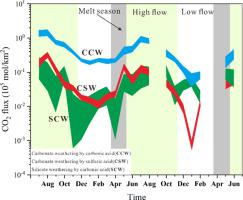当前位置:
X-MOL 学术
›
Chem. Geol.
›
论文详情
Our official English website, www.x-mol.net, welcomes your feedback! (Note: you will need to create a separate account there.)
Assessing the oxidative weathering of pyrite and its role in controlling atmospheric CO2 release in the eastern Qinghai-Tibet Plateau
Chemical Geology ( IF 3.9 ) Pub Date : 2020-06-01 , DOI: 10.1016/j.chemgeo.2020.119605 Dong Zhang , Zhi-qi Zhao , Xiao-dong Li , Li-li Zhang , Ai-chun Chen
Chemical Geology ( IF 3.9 ) Pub Date : 2020-06-01 , DOI: 10.1016/j.chemgeo.2020.119605 Dong Zhang , Zhi-qi Zhao , Xiao-dong Li , Li-li Zhang , Ai-chun Chen

|
Abstract Carbonate weathering, coupled with sulfuric acid, derived from the oxidative weathering of pyrite (OWP), has been suggested to compensate for the CO2 drawdown by silicate weathering over the Cenozoic. However, the above compensation had not been well documented because of the lack of evidence of OWP and the failure to differentiate between sulfide-derived and gypsum-derived sulfate. In this study, monthly sampling campaigns from July 2012 to June 2014 were conducted at Tangnaihai station in the eastern Qinghai-Tibet Plateau (QTP) to demonstrate the behavior of sulfide-derived sulfate and its effect on the local atmospheric CO2 balance. Sulfur and triple oxygen isotopes of sulfate were employed to discern OWP, and sulfur isotope was used to calculate the precise contributions of sulfide-derived sulfate. The results revealed that fractions of riverine sulfate from OWP ranged from 2% to 99% with a mean value of 61%. The corresponding annual CO2 release flux by carbonate weathering coupled with sulfuric acid (CSW) ranged from 0.005 Tmol /yr to 0.015 Tmol /yr with average values of 0.012 Tmol /yr and 0.007 Tmol /yr in 2012–2013 and 2013–2014, respectively, while the annual CO2 consumption flux by silicate weathering coupled with carbonic acid (SCW) varied from 0.003 Tmol /yr to 0.015 Tmol /yr with average annual values of 0.008 Tmol /yr and 0.010 Tmol /yr in 2012–2013 and 2013–2014, respectively. These results indicated that CO2 release by CSW exceeded CO2 consumption by SCW in 2012–2013, but not in 2013–2014. In the uplifting mountain areas, the pyrite oxidation and produced CO2 release sometimes could not balance the CO2 consumption by SCW, and its roles in long term climate change are uncertain. In future research, the role of sulfide oxidation coupled to carbonate weathering should be reestimated to clarify for present and past global climate change.
中文翻译:

青藏高原东部黄铁矿氧化风化作用及其控制大气CO2释放的评价
摘要 黄铁矿氧化风化 (OWP) 产生的碳酸盐风化与硫酸相结合,已被建议用于补偿新生代硅酸盐风化造成的 CO2 下降。然而,由于缺乏 OWP 的证据以及未能区分硫化物衍生硫酸盐和石膏衍生硫酸盐,上述补偿没有得到很好的记录。在这项研究中,2012 年 7 月至 2014 年 6 月在青藏高原东部 (QTP) 的唐奈海站进行了每月采样活动,以展示硫化物衍生硫酸盐的行为及其对当地大气 CO2 平衡的影响。硫酸盐的硫和三氧同位素用于识别 OWP,硫同位素用于计算硫化物衍生硫酸盐的精确贡献。结果表明,OWP 中河流硫酸盐的含量范围为 2% 至 99%,平均值为 61%。相应的碳酸盐风化结合硫酸(CSW)的年 CO2 释放通量范围为 0.005 Tmol /yr 至 0.015 Tmol /yr,2012-2013 和 2013-2014 的平均值分别为 0.012 Tmol /yr 和 0.007 Tmol /yr , 而硅酸盐风化与碳酸 (SCW) 的年 CO2 消耗通量从 0.003 Tmol /yr 到 0.015 Tmol /yr 不等,2012-2013 和 2013-2014 的年均值为 0.008 Tmol /yr 和 0.010 Tmol /yr , 分别。这些结果表明,2012-2013 年,CSW 的 CO2 排放量超过了 SCW 的 CO2 消耗量,但在 2013-2014 年则没有。在隆起的山区,黄铁矿氧化和产生的 CO2 释放有时不能平衡 SCW 的 CO2 消耗,其在长期气候变化中的作用尚不确定。在未来的研究中,应重新估计硫化物氧化与碳酸盐风化耦合的作用,以阐明现在和过去的全球气候变化。
更新日期:2020-06-01
中文翻译:

青藏高原东部黄铁矿氧化风化作用及其控制大气CO2释放的评价
摘要 黄铁矿氧化风化 (OWP) 产生的碳酸盐风化与硫酸相结合,已被建议用于补偿新生代硅酸盐风化造成的 CO2 下降。然而,由于缺乏 OWP 的证据以及未能区分硫化物衍生硫酸盐和石膏衍生硫酸盐,上述补偿没有得到很好的记录。在这项研究中,2012 年 7 月至 2014 年 6 月在青藏高原东部 (QTP) 的唐奈海站进行了每月采样活动,以展示硫化物衍生硫酸盐的行为及其对当地大气 CO2 平衡的影响。硫酸盐的硫和三氧同位素用于识别 OWP,硫同位素用于计算硫化物衍生硫酸盐的精确贡献。结果表明,OWP 中河流硫酸盐的含量范围为 2% 至 99%,平均值为 61%。相应的碳酸盐风化结合硫酸(CSW)的年 CO2 释放通量范围为 0.005 Tmol /yr 至 0.015 Tmol /yr,2012-2013 和 2013-2014 的平均值分别为 0.012 Tmol /yr 和 0.007 Tmol /yr , 而硅酸盐风化与碳酸 (SCW) 的年 CO2 消耗通量从 0.003 Tmol /yr 到 0.015 Tmol /yr 不等,2012-2013 和 2013-2014 的年均值为 0.008 Tmol /yr 和 0.010 Tmol /yr , 分别。这些结果表明,2012-2013 年,CSW 的 CO2 排放量超过了 SCW 的 CO2 消耗量,但在 2013-2014 年则没有。在隆起的山区,黄铁矿氧化和产生的 CO2 释放有时不能平衡 SCW 的 CO2 消耗,其在长期气候变化中的作用尚不确定。在未来的研究中,应重新估计硫化物氧化与碳酸盐风化耦合的作用,以阐明现在和过去的全球气候变化。


























 京公网安备 11010802027423号
京公网安备 11010802027423号